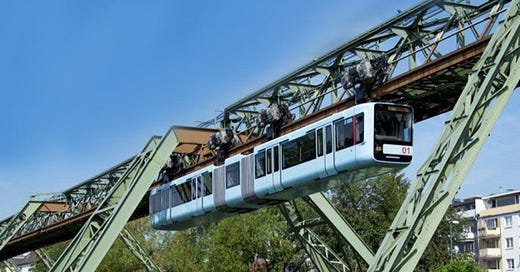Ever Travelled In This Hanging Train?
Monorails have been around since the 1800s, but they came to public attention in the new theme park opened in 1950s, at Disneyland, California. However, suspended monorails have caught people's attention for obvious reasons (hint: the image above). Let's see what they are and how they work.
Crux of the Matter
Is this Suspension Railway (SR)?
Yes! It is a form of elevated monorail in which the vehicle is suspended from a fixed track, unlike aerial cable cars in ropeways. SR is usually built above existing railway tracks, streets or waterways.
Wuppertal's Floating Tram
Situated in Germany, it is the world's oldest electric elevated railway with hanging cars. Designed by Eugen Langen, the first track opened in 1901.
What Happens In Conventional Trains?
Under the influence of centrifugal force, the car body leans a few degrees to the outside of each curve, as seen in the right compartment.
As the centrifugal force pushes everything to the right, it increases the force felt by the passengers. A train has a “soft” suspension if this degree of leaning is large, and “rigid suspension” if it is small.
What About A Suspended Train?
It’s almost same. However, now the floor of the train leans toward the inside of the curve, rather than towards the outside. The suspension system reduces the centrifugal force felt by the passengers, instead of increasing it.
This is also useful in longer distances, when regular trains have to routinely stop in the middle of the track - a stopped train leans to the inside of the curve, which is again uncomfortable for passengers.
Suspended Trains Worldwide
What About India?
The Skybus Metro was a prototype suspended railway in Goa, India. After an accident in the trial run, it was dismantled in 2013.
Curiopedia
John Mathai served as the first Railway Minister of India. The current Railway Minister of the country is Ashwini Vaishnaw.
Curated Coverage



